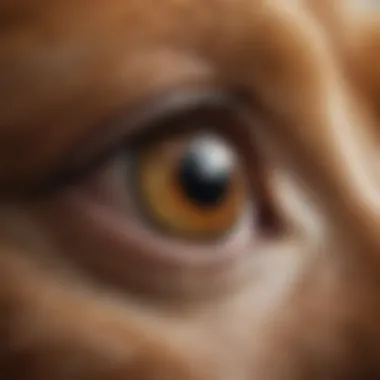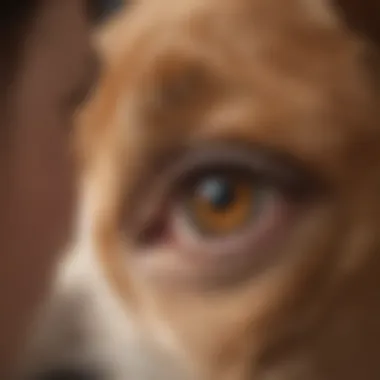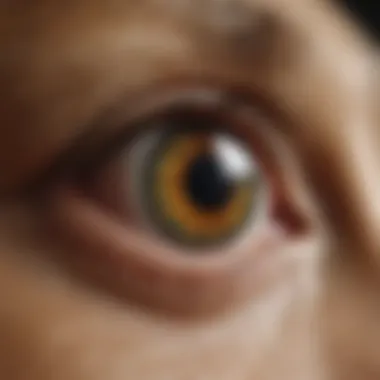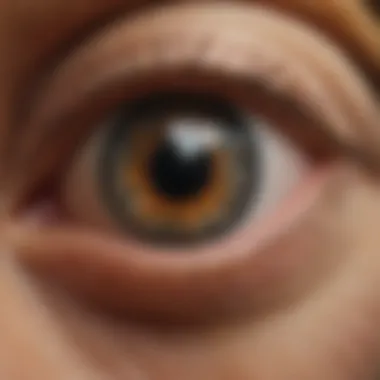Eye Drops for Dogs: Managing Dry Eye Effectively


Intro
Keratoconjunctivitis sicca, commonly known as dry eye, is a significant condition affecting canine health. This ocular ailment arises when a dog's eyes fail to produce adequate tears, leading to discomfort, potential damage to the cornea, and decreased quality of life. The importance of understanding dry eye in dogs cannot be overstated, as early intervention and appropriate treatment can profoundly impact the canine's overall well-being.
The use of eye drops specifically formulated for dogs with dry eye represents a critical aspect of managing this condition. Throughout this article, we will delve deeply into various elements surrounding the use of these eye drops. From detailing the causes and symptoms of dry eye to analyzing the types of eye drops available on the market, our goal is to provide a comprehensive understanding for dog owners and practitioners alike.
In addition, we will shed light on the significance of routine eye care and the need for veterinary consultation when it comes to diagnosing and treating dry eye. By synthesizing current knowledge, this article serves as an essential guide, equipping you with the necessary insights needed to effectively address this ocular issue in dogs.
Understanding Dry Eye in Dogs
Understanding dry eye in dogs is essential for any pet owner. This condition, formally known as keratoconjunctivitis sicca, can lead to significant discomfort and long-term health issues in pets if not addressed properly. Awareness of the symptoms and underlying causes can enable owners to seek timely veterinary intervention. Such knowledge not only aids in managing the condition but also helps in enhancing the quality of life for affected dogs.
Definition of Dry Eye
Dry eye, or keratoconjunctivitis sicca, is a condition where the eyes do not produce enough tears to keep them moist. This deficiency results in a lack of lubrication, leading to irritation, inflammation, and potential damage to the eye tissues. Understanding this condition helps in recognizing the importance of adequate tear production in maintaining eye health.
Anatomy of the Dog's Eye
The Cornea
The cornea is the clear front layer of the eye. It plays a crucial role in focusing light onto the retina. This structure is highly sensitive and needs a constant supply of tears to remain hydrated and functional. The key characteristic of the cornea is its transparency, which is vital for clear vision. In cases of dry eye, the cornea can become inflamed or scarred, which may lead to more serious conditions, making understanding its function important for overall eye health.
Conjunctiva
The conjunctiva is a thin membrane covering the eye’s surface and inner eyelids. It aids in moisture retention across the eye. The unique feature of the conjunctiva is its ability to produce mucus, which helps keep the eye lubricated. In dry eye conditions, a lack of adequate moisture can cause the conjunctiva to become inflamed, resulting in discomfort and redness. Thus, recognizing its role in eye health is vital in understanding dry eye.
Lacrimal Glands
Lacrimal glands are responsible for tear production. They are located above the eye and play a pivotal role in keeping the eye surface moist by producing tears. The key characteristic of lacrimal glands is their ability to respond to various stimuli, such as emotions or irritants, by increasing tear production. When these glands are not functioning properly, it can lead to dry eye symptoms. Understanding the importance of these glands is key to managing and preventing dry eye effectively.
Causes of Dry Eye
Genetic Factors
Certain dog breeds are genetically predisposed to dry eye. These genetic factors play a significant role in determining tear production capabilities. Breeds such as Cavalier King Charles Spaniels and Bulldogs often exhibit issues related to tear deficiency. Recognizing these genetic influences is important for breeding practices and identifying at-risk dogs.
Autoimmune Disorders
Autoimmune disorders can significantly contribute to the development of dry eye. In these cases, the dog's own immune system mistakenly attacks the glands responsible for tear production. This can lead to chronic dry eye, requiring ongoing management and treatment. Understanding the connection between autoimmune disorders and dry eye can help in addressing the underlying health issues in affected dogs.
Medications Impacting Tear Production
Certain medications can negatively impact tear production in dogs. Common medications, such as some antihistamines and pain relievers, can have side effects that reduce moisture in the eyes. Recognizing these potential impacts can aid in preventing dry eye symptoms, ensuring that medications prescribed do not contribute to tear deficiency.
Symptoms of Dry Eye
Redness and Inflammation
Redness and inflammation of the eye are common symptoms of dry eye. The lack of lubrication can lead to irritation, causing the eyes to appear red and swollen. Recognizing these symptoms can prompt pet owners to consult a veterinarian for further assessment.
Excessive Discharge
Excessive discharge from the eyes is another symptom of dry eye. When tear production is inadequate, the eye can become more susceptible to infections, leading to increased mucus and discharge. Understanding this symptom can indicate the need for immediate treatment to prevent further complications.
Frequent Eye Squinting


Frequent eye squinting can occur as the dog attempts to protect its eyes from irritation. This behavior may indicate discomfort and is an important symptom to observe. Owners should be alert to such behaviors, as they can signal the need for veterinary attention to address potential dry eye.
Diagnostic Procedures
When addressing dry eye in dogs, proper diagnostic procedures are essential. These procedures not only confirm the diagnosis but also help in identifying the underlying causes of the condition. Early diagnosis may prevent complications that can arise from untreated dry eye.
Veterinary Examination
The first step in diagnosing dry eye is a thorough veterinary examination. During this exam, the veterinarian assesses the dog's overall health and examines the eyes specifically. They check for signs of conjunctivitis, corneal ulcers, and other ocular issues. This examination can provide valuable insights into the severity of the condition.
A veterinarian may ask about the dog's history, including any previous eye problems or systemic illnesses. This information can aid in pinpointing whether the dry eye is due to genetic factors, autoimmune disorders, or medication side effects. Careful observation and questioning play a crucial role in creating an effective management plan.
Schirmer Tear Test
The Schirmer Tear Test is a widely used diagnostic tool for evaluating tear production. This test measures the quantity of tears produced by placing a thin strip of filter paper in the lower eyelid for a specific period. A lower count of tears indicates dry eye.
Typically, a result of less than 15 millimeters within five minutes marks abnormal tear production. This test is non-invasive and provides quick results, making it fundamental for diagnosing keratoconjunctivitis sicca. The Schirmer Tear Test is an easy starting point before moving on to more complex assessments.
Fluorescein Staining
Fluorescein staining is another diagnostic method utilized in eye examinations. This involves using a special dye that highlights areas of the cornea. When the dye is applied, it adheres to the surface of the cornea, revealing any damage, abrasions, or ulcers.
This test is particularly valuable because it helps differentiate between dry eye and other conditions that might present similar symptoms. It also allows the veterinarian to visualize the cornea's surface, which aids in determining the extent of any damage caused by dryness.
By conducting both the Schirmer Tear Test and fluorescein staining, veterinarians can gather comprehensive data on a dog’s eye health. These diagnostic procedures facilitate accurate diagnosis, guiding effective treatment strategies and eye drop selection.
"Early diagnosis and effective management can significantly improve a dog's quality of life and eye comfort."
Types of Eye Drops for Dogs
Understanding the different types of eye drops available for dogs with dry eye is essential. Each type serves specific functions and addresses various aspects of this condition. Selecting the right eye drops can substantially influence the comfort and health of a dog's eyes. This section covers artificial tears, antibiotic drops, and anti-inflammatory drops. Knowing their purposes and proper administration is beneficial for every pet owner.
Artificial Tears
Selection Criteria
When choosing artificial tears, certain selection criteria plays a crucial role. These criteria include the formulation's viscosity, longevity of tear film retention, and compatibility with the dog's eye conditions. The viscosity of the drops can dictate how long the medication will remain effective. This trait makes some formulations preferable for long-lasting relief, which is vital for managing dry eye symptoms over time. A popular choice due to ease of use, these drops are often preservative-free, reducing the risk of additional irritation. Pet owners should consult their veterinarian to assess which formula aligns best with their dog’s specific needs.
Application Guidelines
Application guidelines for artificial tears require careful attention. Proper administration can make a visible difference in how effective the drops are for the dog. Owners should ensure that the eye surface is clean and free from any debris prior to applying the drops. It is essential to follow the veterinarian's instructions on the frequency of application. This consistency can prove beneficial in alleviating symptoms. Many drops come with a convenient applicator tip that allows for controlled dispensing, and this feature enhances ease of use.
Antibiotic Drops
Indications for Use
Antibiotic drops are typically indicated when there is a secondary bacterial infection accompanying dry eye. This condition can worsen symptoms, making it essential to address both aspects simultaneously. They are a beneficial choice for maintaining overall eye health and preventing complications such as conjunctivitis. When a dog's dry eye is complicated by infections, using antibiotic drops under the guidance of a veterinarian can lead to improved outcomes. Understanding these indications helps owners identify when it is necessary to opt for this treatment over standard eye drops.
Potential Side Effects
Potential side effects of antibiotic drops require diligence and observation from the pet owner. Common side effects include slight irritation or a change in eye discharge. In some cases, a more severe response may occur, warranting immediate veterinary consultation. The key characteristic of these side effects is their variability between individual dogs, making active monitoring essential. Being informed about these potential outcomes allows for proactive management and fosters a more effective response to treatment.
Anti-Inflammatory Drops
Use Cases


The use cases for anti-inflammatory drops range from treating discomfort due to dry eye to managing more severe inflammatory conditions. These drops provide relief by reducing swelling and pain, allowing the dog to feel more comfortable. They are particularly popular for cases where inflammation causes significant discomfort. Identifying these use cases is essential, as it aids in selecting the appropriate treatment based on an individual dog's needs.
Risks and Benefits
The risks and benefits of anti-inflammatory drops must be thoroughly considered. While these drops can provide significant relief, they are not without potential drawbacks. Prolonged use can lead to side effects, including increased intraocular pressure. Conversely, the benefits often outweigh the risks when used judiciously under veterinary supervision. Striking the right balance between the two is crucial in ensuring your dog's ocular health remains stable. Monitoring changes and communicating effectively with the veterinarian support optimal treatment outcomes.
Administering Eye Drops to Dogs
Administering eye drops to a dog is not merely a routine task; it is crucial for managing the discomfort associated with dry eye, or keratoconjunctivitis sicca. Given the common occurrence of this condition in dogs, proper application of eye drops can significantly improve the quality of life for affected pets. Understanding the nuances of this process ensures that pet owners can execute it correctly and effectively, reducing any potential stress for both the owner and the dog.
Preparatory Steps
Before applying eye drops, it is essential to carry out preparatory steps to ensure the process is smooth. Here are some important elements to consider:
- Gather Supplies: Collect all necessary items, such as the prescribed eye drops, clean tissue, and possibly a calm treat for the dog.
- Choose the Location: Select a quiet, comfortable area where the dog feels at ease. This helps minimize distractions during the procedure.
- Check Expiration Dates: Always inspect the eye drop packaging for expiration dates. Using expired medication can be ineffective or even harmful.
- Wash Hands: Clean hands prevent contaminants from entering the dog's eyes.
Taking these preparatory steps creates a conducive environment for administering the eye drops. This approach not only showcases professionalism but also builds trust between the pet and the owner.
Proper Application Techniques
Proper application techniques are critical for the success of the treatment. When applying eye drops, follow these guidelines:
- Position the Dog: Gently hold the dog's head still, either by utilizing your non-dominant hand or by placing the dog in a comfortable position.
- Open the Eye: With your dominant hand, use one finger to gently pull down the lower eyelid, creating a small pocket for the drops.
- Instill the Drops: Tilt the bottle slightly upside down without touching the dog's eye. Squeeze the bottle to release the prescribed number of drops into the pocket created by the eyelid. Ensure the drops are directed toward the inner corner of the eye for optimal distribution.
- Release and Reward: Allow the dog to blink and spread the medication across the eye. Offer a treat or verbal praise to associate the experience with positive reinforcement.
Following these techniques will improve the likelihood of successful eye drop application, ensuring adequate treatment of dry eye symptoms.
Post-Application Care
Post-application care is essential for maximizing the benefits of the eye drops and ensuring the dog remains comfortable. Consider these recommendations:
- Observe the Dog: Watch for any signs of discomfort or adverse reactions following the application. If excessive tearing or redness occurs, consult a veterinarian.
- Avoid Rubbing: Discourage the dog from rubbing their eyes after application. This can compromise the treatment's effectiveness and may harm the eye.
- Follow Up: Schedule routine checks with a veterinarian to monitor the progress and adjust treatment as needed.
"Regular post-application care is critical to the overall success of managing dry eye in dogs."
Incorporating these steps into your routine reinforces the commitment to your dog's eye health. The ongoing management of eye drops can lead to better outcomes and a more comfortable life for your canine companion.
Considerations for Pet Owners
When managing a dog with dry eye, pet owners must be equipped with comprehensive knowledge. Understanding this condition is crucial for ensuring optimal well-being. Dry eye, or keratoconjunctivitis sicca, can significantly impact a dog's quality of life. Owners are in a unique position to observe subtle changes, which can be vital for treatment effectiveness. Besides traditional eye drops, a range of alternative treatments exist. Pet owners should be aware of these options and how they may complement prescribed therapies.
Monitoring Symptoms
Pet owners play a key role in monitoring symptoms related to dry eye. Consistent observation can reveal important changes in the dog's condition. Common symptoms to watch for include:
- Redness or discoloration of the eye
- Excessive tearing or discharge
- Frequent squinting or discomfort
- Behavioral changes, such as increased irritability or unwillingness to play
Proper monitoring helps indicate whether the eye drops are effective. If symptoms worsen or new signs appear, this information is invaluable for veterinary consultation. Keeping a journal of symptoms can assist in detailed discussions with the veterinarian, leading to better targeted treatments.
When to Consult a Veterinarian
Timely consultation with a veterinarian is essential for managing dry eye effectively. Knowing when to seek professional advice can prevent complications. Indicators that warrant immediate consultation include:
- Severe brightness or sensitivity to light
- Constant rubbing or pawing at the eye
- Inconsistently responding to previously effective treatments
- Any noticeable change in behavior or appetite
Veterinarians can provide specialized care and may suggest additional diagnostic tests, such as the Schirmer Tear Test. This information may lead to adjustments in treatment plans or identification of underlying issues that may not have been previously considered.


For effective long-term management, regular veterinary check-ups are advised. This not only ensures that the treatment plan is working but also fosters a deeper understanding of an individual dog's needs, further enhancing their quality of life.
Alternative Treatments for Dry Eye
Alternative treatments for dry eye in dogs can play a significant role in managing this condition, particularly when traditional methods fall short. While eye drops offer immediate relief, complementary approaches can enhance overall eye health and support tear production. Understanding these alternatives can empower pet owners to make informed decisions and adopt holistic strategies for their canine companions.
Dietary Adjustments
Nutrition is fundamental in supporting eye health. Certain dietary adjustments can make a difference in how a dog's body produces tears and maintains moisture.
- Essential Fatty Acids: Omega-3 and Omega-6 fatty acids are well-known for their anti-inflammatory properties. Including fish oil or flaxseed oil in a dog's diet can help promote tear production and reduce inflammation.
- Hydration Needs: Ensuring that dogs stay well-hydrated is also important. Fresh, clean water should always be available.
- Quality Dog Food: A high-quality dog food enriched with vitamins A, C, and E along with antioxidants may benefit overall eye health. It's vital to avoid foods with fillers or artificial additives that can hinder health.
Overall, a well-rounded diet can enhance the effectiveness of eye treatments and contribute positively to a dog's ocular wellbeing.
Supplemental Therapies
In addition to dietary changes, various supplemental therapies can be beneficial for dogs suffering from dry eye.
- Natural Supplements: Products containing antioxidants, such as Bilberry extract or Lutein, can support eye health. Always consult a veterinarian before introducing new supplements to ensure compatibility with existing treatments.
- Topical Remedies: Some pet owners find success with topical treatments, such as herbal ointments or gels, designed specifically for dogs. These can help soothe irritation and provide moisture.
- Environmental Adjustments: Creating a conducive environment is crucial. Reducing air drafts, using humidifiers, and minimizing exposure to irritants can help alleviate dry eye symptoms.
By approaching dry eye through these alternative treatments, pet owners can enhance their dog's comfort and health. This collaborative method, combining traditional and alternative strategies, ensures a comprehensive care plan that addresses both immediate and ongoing needs for dogs with keratoconjunctivitis sicca.
Lifelong Management of Dry Eye
Managing dry eye in dogs requires a sustained commitment from pet owners. This condition, also known as keratoconjunctivitis sicca, necessitates a proactive approach to ensure optimal eye health. Lifelong management focuses not just on symptom alleviation, but also on long-term eye preservation and overall well-being of the pet. It is crucial for pet owners to understand that dry eye management is not a one-time effort, but an ongoing strategy that potentially enhances the quality of life for their dogs.
Routine Eye Care Practices
Routine eye care is foundational for dogs with dry eye. Regular cleaning and monitoring of the eyes can prevent discomfort and secondary infections. Here are key practices to adopt:
- Daily Cleaning: Use a clean, damp cloth to wipe away any discharge. This prevents buildup and irritation.
- Moisture Application: Administer prescribed eye drops consistently. Maintaining moisture in the eyes is vital.
- Observation: Monitor changes in symptoms such as redness or discharge. Early detection of worsening symptoms facilitates timely veterinary intervention.
It is beneficial to create a structured schedule for eye care, as consistency reinforces the routine for both the pet and owner.
Regular Veterinary Check-Ups
Regular veterinary examinations are indispensable for effective management of dry eye. These check-ups provide opportunities to:
- Assess Condition: The veterinarian can evaluate the effectiveness of the current treatment plan. Adjustments can be made based on the dog’s response.
- Screen for Complications: Early detection of potential complications, such as infection or further ocular damage, can save vision.
- Update Treatments: As the dog's health evolves, eye drop formulations may need to be adjusted or changed to better suit their individual needs.
Establishing a check-up schedule every 6 to 12 months is generally advisable. Comprehensive evaluations have the potential to uncover underlying issues, ensuring that dogs with dry eye receive the best care possible.
In summary, lifelong management of dry eye not only mitigates discomfort but also preserves the health of the eye, ensuring a higher quality of life for affected dogs.
Culmination
In the context of managing dry eye in dogs, the conclusion encapsulates numerous essential aspects discussed throughout the article. Dry eye, also known as keratoconjunctivitis sicca, presents challenges not only to the affected dogs but also to their owners. Understanding the importance of appropriate eye drops, effective administration techniques, and ongoing care is crucial.
The summarized insights provide a framework for pet owners to prioritize their dog’s ocular health. Eye drops, whether artificial tears or anti-inflammatory agents, must be selected based on the specific needs of the dog. Veterinary consultation plays a pivotal role in determining the right treatment plan. Moreover, monitoring symptoms closely allows for early intervention when necessary.
"Routine eye care practices and regular veterinary check-ups are vital components in managing dry eye effectively."
Summary of Key Points
- Understanding Dry Eye: Dry eye is a common condition in dogs that requires immediate attention for its long-term consequences.
- Types of Eye Drops: Various eye drops exist to address different aspects of dry eye, including artificial tears, antibiotics, and anti-inflammatory medications.
- Administering Eye Drops: Proper techniques for administration help ensure effective treatment and minimize discomfort.
- Monitoring and Consultation: Owners must keep track of their dog’s symptoms and consult with veterinarians to adapt treatment as needed.
- Long-Term Management: Incorporating routine care and dietary adjustments can support lifelong eye health for dogs with chronic conditions.
Final Thoughts on Dry Eye Management
Managing dry eye in dogs is more than just about applying eye drops. It is an ongoing process that involves understanding the condition, recognizing symptoms, and adapting treatments over time. Pet owners should not underestimate the emotional bond they maintain with their pets; ensuring comfort while managing a chronic condition can enhance this bond.
Using the information outlined in this article, owners can nurture their pet's health. It is crucial to approach dry eye management holistically, integrating eye drops with routine veterinary visits and potential dietary changes.
Ultimately, being proactive empowers owners to significantly improve their dog's quality of life while fostering a collaborative relationship with their veterinary team.



